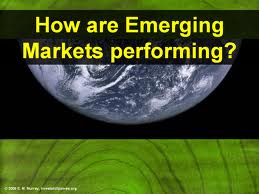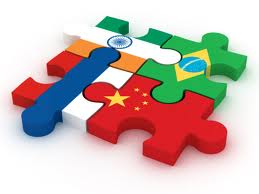Emerging markets
Emerging markets are nations with social or business activity in the process of rapid growth and industrialization. based on data from 2006 there are around 28 emerging markets (according to 2010 data there are more than 40 emerging marketsin the world, with the economies of China and India considered to be the largest According to The Economist many people find the term outdated, but no new term has yet to gain much traction
The ASEAN–China Free Trade Area, launched on January 1, 2010, is the largest regional emerging market in the world
Terminology
Developing countries that are neither part of the least developed countries, nor of the newly industrialized countries
In the 1970s, “less economically developed countries” (LEDCs) was the common term for markets that were less “developed” (by objective or subjective measures) than the developed countries such as the United States, Western Europe, and Japan. These markets were supposed to provide greater potential for profit, but also more risk from various factors. This term was felt by some to be not positive enough so the emerging market label was born. This term is misleading in that there is no guarantee that a country will move from “less developed” to “more developed”; although that is the general trend in the world, countries can also move from “more developed” to “less developed”.
Originally brought into fashion in the 1980s by then World Bank economist Antoine van Agtmael the term is sometimes loosely used as a replacement for emerging economies, but really signifies a business phenomenon that is not fully described by or constrained to geography or economic strength; such countries are considered to be in a transitional phase between developing and developed status. Examples of emerging markets include Indonesia, Iran, some countries of Latin America, some countries in Southeast Asia, most countries in Eastern Europe, Russia, some countries in the Middle East, and parts of Africa. Emphasizing the fluid nature of the category, political scientist Ian Bremmer defines an emerging market as “a country where politics matters at least as much as economics to the markets.
The research on emerging markets is diffused within management literature. While researchers including C. K. Prahalad, George Haley, Hernando de Soto, Usha Haley, and several professors from Harvard Business School and Yale School of Management have described activity in countries such as India and China, how a market emerges is little understood.
In the 2008 Emerging Economy Report the Center for Knowledge Societies defines Emerging Economies as those “regions of the world that are experiencing rapid informationalization under conditions of limited or partial industrialization.” It appears that emerging markets lie at the intersection of non-traditional user behavior, the rise of new user groups and community adoption of products and services, and innovations in product technologies and platforms.
Newly industrialized countries as of 2010. This is an intermediate category between fully developed and developing.
The term “rapidly developing economies” is being used to denote emerging markets such as The United Arab Emirates, Chile and Malaysia that are undergoing rapid growth.
In recent years, new terms have emerged to describe the largest developing countries such as BRIC that stands for Brazil, Russia, India, and China along with BRICET (BRIC + Eastern Europe and Turkey), BRICS (BRIC + South Africa), BRICM (BRIC + Mexico) , BRICK (BRIC + South Korea), Next Eleven (Bangladesh, Egypt, Indonesia, Iran, Mexico, Nigeria, Pakistan, Philippines, South Korea, Turkey, and Vietnam) and CIVETS (Colombia, Indonesia, Vietnam, Egypt, Turkey and South Africa) These countries do not share any common agenda, but some experts believe that they are enjoying an increasing role in the world economy and on political platforms.
It is difficult to make an exact list of emerging (or developed) markets; the best guides tend to be investment information sources like ISI Emerging Markets and The Economist or market index makers (such as Morgan Stanley Capital International). These sources are well-informed, but the nature of investment information sources leads to two potential problems. One is an element of historicity; markets may be maintained in an index for continuity, even if the countries have since developed past the emerging market phase. Possible examples of this are South Korea and Taiwan. A second is the simplification inherent in making an index; small countries, or countries with limited market liquidity are often not considered, with their larger neighbours considered an appropriate stand-in.
In an Opalesque.TV video, hedge fund manager Jonathan Binder discusses the current and future relevance of the term “emerging markets” in the financial world. Binder says that in the future investors will not necessarily think of the traditional classifications of “G10″ (or G7) versus “emerging markets”. Instead, people should look at the world as countries that are fiscally responsible and countries that are not. Whether that country is in Europe or in South America should make no difference, making the traditional “blocs” of categorization irrelevant.
The Big Emerging Market (BEM) economies are (alphabetically ordered): Brazil, China, Egypt, India, Indonesia, Mexico, Philippines, Poland, Russia, South Africa, South Korea and Turkey
Newly industrialized countries are emerging markets whose economies have not yet reached first world status but have, in a macroeconomic sense, outpaced their developing counterparts.
Individual investors can invest in emerging markets either through ADRs (American depositor Receipts – stocks of foreign companies that trade on US stock exchanges) or through exchange traded funds (exchange traded funds or ETFs hold basket of stocks). The exchange traded funds can be focused on a particular country (e.g., China, India) or region (e.g., Asia-Pacific, Latin America).
The FTSE Group distinguishes between Advanced and Secondary Emerging markets on the basis of their national income and the development of their market infrastructure. The Advanced Emerging markets are classified as such because they are upper middle income GNI countries with advanced market infrastructures or high income GNI countries with lesser developed market infrastructures.
The Advanced Emerging markets are:
| Brazil | Hungary | Mexico |
| Poland | South Africa | Taiwan |
The Secondary Emerging markets include some upper middle, lower middle and low income GNI countries with reasonable market infrastructures and significant size and some upper middle income GNI countries with lesser developed market infrastructures. The secondary emerging markets are:
| Chile | China | Colombia | Czech Republic |
| Egypt | India | Indonesia | Malaysia |
| Morocco | Pakistan | Peru | Philippines |
| Russia | Thailand | Turkey | UAE |
MSCI list
As of May 2010, MSCI Barra classified the following 21 countries as emerging markets
The list tracked by The Economist is the same, except with Hong Kong, Singapore and Saudi Arabia included (MSCI classifies the first two as developed markets and the third one as a frontier market).
S&P list
As of 31 December 2010, Standard and Poor’s classified the following 19 countries as emerging markets
Dow Jones list
As of May 2010, Dow Jones classified the following 35 countries as emerging markets:
Global Growth Generators
“Global Growth Generators”, or 3G (countries), is an alternative classification determined by Citigroup analysts as being countries with the most promising growth prospects for 2010-2050. These consist of Indonesia, Egypt (but not Turkey), seven other emerging countries, and two countries not previously listed before, specifically Iraq and Mongolia. The only country to appear in all emerging market lists or groups is Indonesia.
Six major emerging economies
According to World Bank issued at May 2011, BRIC countries plus South Korea and Indonesia will lead the world’s economy with more than a half of all global growth by 2025.
SUMBER : http://en.wikipedia.org/wiki/Emerging_markets


Tidak ada komentar:
Posting Komentar